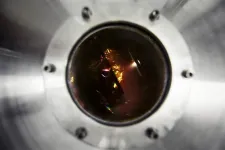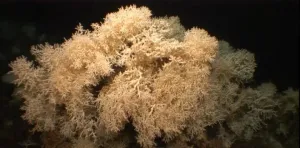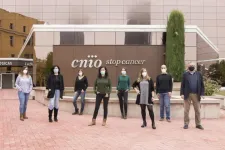Producing green hydrogen through the exposure of nanomaterials to sunlight
A research team from INRS has joined forces with French researchers from ICPEES to pave the way towards the production of green hydrogen
2021-01-21
(Press-News.org) A research team from the Institut national de la recherche scientifique (INRS) has joined forces with French researchers from the Institute of Chemistry and Processes for Energy, Environment and Health (ICPEES), a CNRS-University of Strasbourg joint research lab, to pave the way towards the production of green hydrogen. This international team has developed new sunlight-photosensitive-nanostructured electrodes. The results of their research were published in the November 2020 issue of the journal of Solar Energy Materials and Solar Cells.
An Energy Transition Vector
Hydrogen is being considered by several countries of the Organisation for Economic Co-operation and Development (OECD) as a key player in the transition towards decarbonized industries and sectors. According to the INRS Professor My Ali El Khakani, Quebec could strategically position itself in this energy sector of the future. "Thanks to high-performance nanomaterials, we can improve the efficiency of water dissociation to produce hydrogen. This "clean" fuel is becoming increasingly important for the decarbonisation of the heavy-duty trucking and public transportation. For example, buses using hydrogen as a fuel are already in operation in several European countries and in China. These buses emit water instead of greenhouse gases," added the physicist and nanomaterials specialist.
Splitting water molecules into oxygen and hydrogen has long been done by electrolysis. However, industrial electrolyzers are very energy-intensive and require large investments. The INRS and ICPEES researchers were rather inspired by a natural mechanism: photosynthesis. Indeed, they have developed specially engineered and structured electrodes that split water molecules under the sun's light. This is a process known as photocatalysis.
Challenges in the Design and Fabrication of the Nanostructured Electrodes
For maximum use of solar energy, the research teams have selected a very abundant and chemically stable material: titanium dioxide (TiO2). TiO2 is a semiconductor known for being photosensitive to UV-light, which accounts only for 5% of the solar irradiance. Researchers have used their expertise in the field to first change the atomic composition of TiO2 and extend its photosensitivity to visible light. They were able to produce electrodes that can absorb up to 50% of the light emitted by the sun. A significant gain right from the start!
The researchers have then proceeded with the nanostructuration of the electrode to form a network of TiO2 nanotubes that resembles a beehive-like structure. This method multiplied the effective surface area of the electrode by a factor of 100,000 or more. "Nanostructuring maximizes the ratio between surface and volume of a material. For example, TiO2 nanostructures can offer a surface area of up to 50 m2 per gram. That's the surface area of a mid-size flat!", Professor El Khakani enthusiastically pointed out.
The final step of the electrode elaboration is their "nanodecoration". This process consists of depositing catalyst nanoparticles on the otherwise infinite network of TiO2 nanotubes to increase their efficiency of hydrogen production. To achieve this nanodecoration step, the researchers used the laser ablation deposition technique, a field where Professor El Khakani has developed a unique expertise over the last 25 years. The challenge was not only to control the size, dispersion and anchorage of catalyst nanoparticles on the TiO2 nanotube matrix, but also to find alternatives to the costly iridium and platinum classical catalysts.
This research identified cobalt oxide (CoO), a material that is quite available in Quebec's underground, as effective co-catalysts for splitting water molecules. A comparison of the two materials showed that CoO nanoparticles enabled a tenfold increase the photocatalytic efficiency of these new nanodecorated electrodes under visible light compared to bare nanotubes.
INFORMATION:
About the study
The article "Comparative study of the photocatalytic effects of pulsed laser deposited CoO and NiO nanoparticles onto TiO2 nanotubes for the photoelectrochemical water splitting", by Thomas Favet, Thomas Cottineau, Valérie Keller and My Ali El Khakani, was published in the November 2020 issue of the journal of Solar Energy Materials and Solar Cells. Researchers received financial support from the Natural Sciences and Engineering Research Council of Canada (NSERC) and the Fonds de recherche du Québec - Nature et technologies (FRQNT). The project was also partially funded, in France, by the Agence Nationale de la Recherche (ANR).
About INRS
INRS is a university dedicated exclusively to graduate level research and training. Since its creation in 1969, INRS has played an active role in Quebec's economic, social, and cultural development and is ranked first for research intensity in Quebec and in Canada. INRS is made up of four interdisciplinary research and training centres in Quebec City, Montreal, Laval, and Varennes, with expertise in strategic sectors: Eau Terre Environnement, Énergie Matériaux Télécommunications, Urbanisation Culture Société, and Armand-Frappier Santé Biotechnologie. The INRS community includes more than 1,400 students, postdoctoral fellows, faculty members, and staff.
Source :
Audrey-Maude Vézina
Service des communications de l'INRS
418 254-2156
audrey-maude.vezina@inrs.ca
[Attachments] See images for this press release:

ELSE PRESS RELEASES FROM THIS DATE:
2021-01-21
CHICAGO (January 21, 2021): A multimodal pain regimen (MMPR) designed to minimize opioid exposure and relieve acute pain associated with traumatic injury kept patient self-reported pain scores low while also reducing the daily and total amount of opioid drugs given to trauma patients. Results from the first study of its kind to evaluate an MMPR in a rigorous, randomized controlled trial are published online as an "article in press" by the Journal of the American College of Surgeons in advance of print.
"Opioids should not be considered the pillar of treatment for acute pain after injury," said lead study author John A. Harvin, MD, FACS, an associate professor for the department of surgery, McGovern Medical School, The University of Texas Health Science Center at Houston (UTHealth) ...
2021-01-21
What The Study Did: This JAMA Insights review provides clinical details of anaphylactic reactions reported to and verified by the Centers for Disease Control and Prevention in the first week of use of the Pfizer-BioNTech COVID-19 vaccine in the United States.
Authors: Tom Shimabukuro, M.D., M.P.H., M.B.A., of the CDC in Atlanta, is the corresponding author.
To access the embargoed study: Visit our For The Media website at this link https://media.jamanetwork.com/
(doi:10.1001/jama.2021.0600)
Editor's Note: Please see the article for additional information, including other authors, author ...
2021-01-21
A new study from the Institut de Ciències del Mar (ICM-CSIC, Spain) and the National Oceanography Centre brings unprecedented insights into the environmental constraints and climatic events that controlled the formation of these reefs.
The results of this research will help understand how cold-water coral reefs can react to the effects caused by the present-day climate change.
Similar to tropical coral reefs, cold-water coral reefs are incredible hotspots of biodiversity, with the difference that they do not rely on symbiosis with microscopic algae, and therefore can be found in the dark and deep waters of our oceans. Despite their uniqueness and key functional role in the ocean, they are still partially ...
2021-01-21
Breast cancer investigators in the Lambe Institute at NUI Galway have collaborated on a pivotal international study into breast cancer risk which was published in the New England Journal of Medicine today (Wednesday, 20 January). The results of the study have identified that there are nine specific genes associated with breast cancer risk.
Contributing authors Professor Michael Kerin, Chair of Surgery at NUI Galway, Director of the Cancer Managed Clinical Academic Network for Saolta University Health Care Group, along with Dr Nicola Miller, Lecturer in NUI Galway's School of Medicine, have directed the Breast Cancer in Galway Genetics Study (BIGGS) since 2008. DNA samples, which have been collected from 2,000 Irish ...
2021-01-21
Genetic inheritance affects the likelihood of developing breast cancer. Some genes are already known to increase cancer risk; other genes are suspected to be involved, but not to what extent. It is crucial to clarify this issue to improve prevention since it opens the way to more personalised follow-up and screening programs. A large international consortium, which includes the Spanish National Cancer Research Centre (CNIO), has studied 34 putative susceptibility genes on samples from 113,000 female breast cancer cases and controls, and its results confirm the importance ...
2021-01-21
When university campuses sent students, staff and faculty members home in March, Padmini Rangamani, a professor at the University of California San Diego, suddenly found herself running her research lab remotely, teaching her classes online, and supervising her two children, ages 10 and 13, who are also learning online.
To deal with the stress the situation created, Rangamani turned to a support network of fellow female faculty members around the United States. They chatted and texted and eventually decided to write a scholarly article with recommendations for all other female principal investigators in academia.
The article, "Ten simple rules for women principal investigators during a pandemic," ...
2021-01-21
Generating membranes using electrochemical polymerization, or electropolymerization, could provide a simple and cost-effective route to help various industries meet increasingly strict environmental regulations and reduce energy consumption.
Researchers from KAUST have produced membranes with well-defined microscopic pores by electrochemically depositing organic conjugated polymers onto highly porous electrodes. These microporous membranes have numerous applications, ranging from organic solvent nanofiltration to selective molecular transport technologies.
High-performance separation depends on membranes that are robust with well-ordered and dense microporous structures, such as zeolites and ...
2021-01-21
Scientists from an international collaboration have found evidence of alpha particles at the surface of neutron-rich heavy nuclei, providing new insights into the structure of neutron stars, as well as the process of alpha decay.
Neutron stars are amongst the most mysterious objects in our universe. They contain extremely dense matter that is radically different from the ordinary matter surrounding us--being composed almost entirely of neutrons rather than atoms. However, in the nucleus at the center of normal atoms, matter exists at similar densities.
"Understanding the nature of matter at such extremes is important for our understanding of neutron stars, as well as the beginning, ...
2021-01-21
COVID-19 has been spreading rapidly over the past several months, and the U.S. death toll has now reached 400,000. As evident from the age distribution of those fatalities, COVID-19 is dangerous not only for the elderly but for middle-aged adults, according to a Dartmouth-led study published in the European Journal of Epidemiology.
"For a person who is middle-aged, the risk of dying from COVID-19 is about 100 times greater than dying from an automobile accident," explains lead author Andrew Levin, a professor of economics at Dartmouth College. "Generally speaking, very few children and young adults die of COVID-19. However, the risk is progressively greater for middle-aged and older adults. The odds that ...
2021-01-21
The bipolar membrane, a type of ion exchange membrane, is considered the pivotal material for zero emission technology. It is composed of an anode and cathode membrane layer, and an intermediate hydrolysis layer. Under reverse bias, the water molecules in the intermediate layer produce OH- and H+ by polarization.
Large-scale production of the membrane is hindered by the different expansion coefficients of the anode and cathode layers, causing the two layers easy to delaminate. Besides, the mostly used intermediate catalysts are small molecules or transition, which are instable and inefficient.
In a study published on Nature Communications, a team led by ...
LAST 30 PRESS RELEASES:
[Press-News.org] Producing green hydrogen through the exposure of nanomaterials to sunlight
A research team from INRS has joined forces with French researchers from ICPEES to pave the way towards the production of green hydrogen




